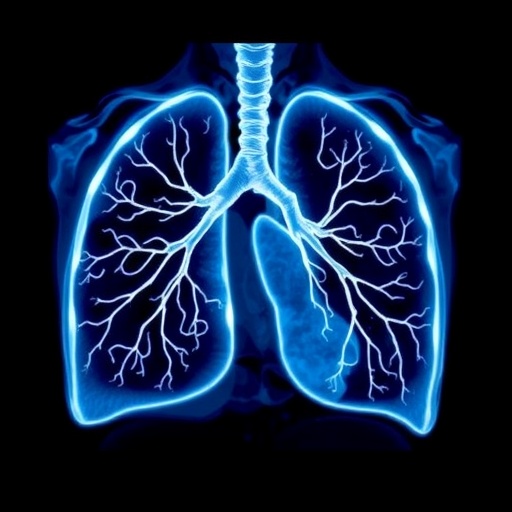In a groundbreaking study published in BioMedical Engineering OnLine, researchers have unveiled compelling evidence supporting the superiority of concurrent chemoradiotherapy (CCRT) over sequential chemoradiotherapy (SCRT) in treating non-small cell lung cancer (NSCLC). This comprehensive analysis not only highlights improved survival outcomes but delves deeply into the nuanced physiological responses and tumor marker dynamics associated with these treatment modalities, offering fresh insights into optimizing lung cancer therapy.
Lung cancer remains one of the leading causes of cancer-related mortality worldwide, with NSCLC accounting for the majority of cases. Despite advances in treatment, therapeutic strategies must constantly evolve to enhance patient survival and quality of life. Traditional sequential chemoradiotherapy, in which chemotherapy and radiotherapy are administered one after another, has been a mainstay but is increasingly challenged by CCRT, where these therapies are delivered simultaneously—a technique theorized to improve synergistic tumor cell killing.
The study retrospectively analyzed clinical data from 158 NSCLC patients treated between January 2020 and December 2022. Patients were segregated into two cohorts: one receiving SCRT (78 patients) and the other CCRT (80 patients). Lesion size quantification through CT imaging served as a crucial metric for assessing clinical efficacy. Beyond tumor response, the investigation extended to tracking pulmonary function parameters like forced expiratory volume in one second (FEV1), forced vital capacity (FVC), and the FEV1/FVC ratio—key indicators of respiratory health often compromised in lung cancer patients undergoing radiation.
An intricate part of the analysis involved serum tumor markers including CA125, SCC antigen, and CYFRA21-1, which correlate with tumor burden and treatment response. Monitoring the fluctuations in these biomarkers over a long-term window of 36 months provided a molecular perspective on therapeutic impact. To robustly compare mortality and disease progression, Kaplan–Meier survival curves were employed, elucidating differences in overall survival rate (OSR), progression-free survival (PFS), and overall survival (OS) between the two cohorts.
Results demonstrated a striking difference in remission rates, where the observation group (CCRT) exhibited a 90.00% remission compared to 74.36% in the control group (SCRT). The control rates mirrored this trend, with 96.25% for CCRT patients versus 89.74% for SCRT. These statistically significant improvements point toward a more potent antitumor effect when chemotherapy and radiotherapy are administered concurrently, likely due to enhanced radiosensitization mediated by chemotherapeutic agents.
While treatment efficacy improved, adverse effects are a critical consideration. Notably, the incidence of radiation pneumonitis—an inflammation of lung tissues induced by radiotherapy—was higher in CCRT patients (25.00%) relative to those receiving SCRT (8.97%). However, the severity of radiation-induced lung injuries diverged, with SCRT patients experiencing more grade IV toxicities, indicating a more deleterious lung impact despite lower incidence rates. This complex balance between toxicity and therapeutic benefit reinforces the need for personalized treatment planning in clinical settings.
The study’s pulmonary function assessments revealed significant post-treatment improvements in both groups. However, increases in FEV1, FVC, and FEV1/FVC were markedly greater in the CCRT group, suggesting that this approach not only effectively combats cancer but also assists in preserving and potentially enhancing lung capacity. This functional preservation is particularly vital in NSCLC patients, where maintaining respiratory function correlates strongly with quality of life and overall prognosis.
Serum tumor marker analysis underscored the molecular advantage of CCRT. Lower post-treatment levels of CA125, SCC antigen, and CYFRA21-1 were consistently observed in the concurrent treatment cohort, indicating a more profound reduction in tumor activity. These biochemical markers not only serve as surrogates for treatment success but may also provide clinicians with invaluable feedback for tailoring ongoing therapy.
Survival outcomes further cemented the superiority of concurrent chemoradiotherapy. The OSR in the CCRT group reached 90.00%, outpacing the 83.33% observed in SCRT patients, though this difference did not reach statistical significance. However, progression-free survival and overall survival were significantly enhanced in the concurrent treatment cohort, highlighting its potential to prolong patient life and delay disease advance.
The study contributes a critical understanding that while CCRT elevates radiation pneumonitis risk, the overall toxicity profile does not increase disproportionately. This suggests that, with careful monitoring and management, the benefits of concurrent therapy can far outweigh the risks. Consequently, the research team advocates for tailoring treatment protocols based on individual patient profiles to maximize therapeutic outcomes while mitigating adverse effects.
These findings stand to influence clinical decision-making paradigms, encouraging oncologists to weigh the enhanced efficacy of CCRT against manageable toxicity concerns. The nuanced interplay of improved tumor control, pulmonary function enhancement, and survival benefits positions concurrent chemoradiotherapy as a formidable option in the evolving landscape of NSCLC treatment.
In summary, this landmark investigation elucidates the multifaceted advantages of concurrent chemoradiotherapy over its sequential counterpart. By integrating comprehensive clinical metrics, radiologic assessments, pulmonary function tests, biomarker analysis, and survival data, the study crafts a compelling narrative of improved efficacy and manageable safety in treating lung cancer patients.
As lung cancer therapeutics continue to advance, incorporating such evidence-based insights into practice offers hope for better patient prognoses and a potential shift in standard care. Future studies are warranted to explore optimization strategies, including individualized dosing schedules and supportive interventions to further mitigate radiation pneumonitis risks.
In an era where multidisciplinary approaches define cancer care, this research reaffirms the importance of harmonizing chemotherapy and radiotherapy protocols. Concurrent chemoradiotherapy emerges as a promising modality that not only intensifies antitumor efficacy but also pragmatically balances toxicity, paving the way for improved survival and quality of life for thousands of NSCLC patients worldwide.
Subject of Research: Comparative clinical efficacy and safety of concurrent versus sequential chemoradiotherapy in non-small cell lung cancer patients.
Article Title: Concurrent vs. sequential chemoradiotherapy: a survival boost for lung cancer patients
Article References:
Xu, J., Ji, Q., Deng, J. et al. Concurrent vs. sequential chemoradiotherapy: a survival boost for lung cancer patients. BioMed Eng OnLine 24, 60 (2025). https://doi.org/10.1186/s12938-025-01390-9
Image Credits: AI Generated




